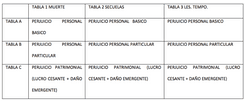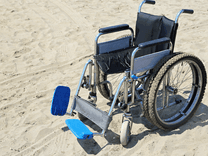One of the most disabling injuries that a person can suffer after a traffic accident is quadriplegia. This condition damages severely the spinal cord above the thoracic vertebra and although it can present itself in many forms, the most common is the irreversible, partial or total paralysis of the trunk and limbs. Its consequences not only affect the victim for life, but also his or her family and relatives, which is why calculating the amount of compensation for quadriplegia after a traffic accident is very complex.
If you want to know what compensation for quadriplegia consists of, here are the most important aspects to take into account in this type of claim.
What is the compensation for quadriplegia in an accident?
Quadriplegia is synonymous with disability, as it is one of the most serious spinal traumas that exist. For medical science, the possibilities of reversing the extent of this injury are very low or practically nil, although in specific cases, some victims may recover a fraction of mobility in some of their limbs after a tough rehabilitation process.
Therefore, quadriplegia means a radical change in the life of the injured people and that of their relatives, as they need constant care and attention in their day-to-day life. For this reason, Law 35/2015 in the schedule of compensation for traffic accidents contemplates different items for calculating compensation for quadriplegia, which we will explain below.
Compensation for quadriplegia that can be claimed for
In a claim for compensation for tetraplegia, the affected person can request compensation for temporary injuries, for the time that elapses between the traffic accident and the stabilisation of the injury, and also for permanent injuries or sequelae.
In addition, compensation can also be claimed for pecuniary damage. That is to say, for the medical expenses incurred since the accident occurred and for those that you will have to pay for the rest of your life, as well as for the income that you will no longer be able to earn because you will no longer be able to carry out your professional activity as before the accident.
Temporary injuries
Compensation for temporary injuries compensates for the damage caused to the victim during the period of healing or stabilisation of his or her injuries. If the injured person suffers a quadriplegia, he/she is entitled to claim this type of compensation.
The amount will depend on the number of days and the type of damage caused to the victim:
- Days in the ICU: very serious injury.
- Days of hospitalisation: serious injury.
- Days of incapacity: moderate harm.
- Non-impeding days: basic injury.
In addition, for each of the operations or surgical interventions required by the injured party, compensation may also be requested. The amount will depend on the group of surgical interventions to which each operation belongs.
After-effects (Particular Damage - Table 2.A)
Although quadriplegia can be compensated as a temporary injury, once it is stabilised, since it causes irreversible damage, it becomes a permanent injury or sequela. Therefore, the affected person is also entitled to claim compensation for this concept.
The valuation of the after-effects of quadriplegia depends on the area of the spinal column that has suffered the damage. According to the scale, there are three zones and depending on these, the injury is scored from 0 to 100:
- From vertebra C1 to C4 (no mobility): 100 points.
- From vertebrae C5 to C6 (mobility of the shoulder and scapular girdle): between 96 and 98 points.
- From vertebrae C7 to C8 (mobility of the upper limbs): between 93 and 95 points.
In addition, the scale establishes an increase in the amount of this compensation depending on the particular damage that the sequela cause to the victim. These damages are:
- Additional moral damages for psychophysical harm.
- Complementary moral damages for aesthetic damage.
- Moral damages for loss of quality of life.
- Moral damages for loss of quality of life of family members.
- Loss of the foetus as a result of the accident.
- Exceptional damage.
Patrimonial loss (Emerging damage - Table 2.C).
In a compensation for quadriplegia, compensation can also be claimed for the pecuniary loss caused to the injured person. In other words, for all the costs of health care, hospitalisation, pharmaceutical treatment, etc., that the injured person has needed during the healing period of the temporary injuries.
The compensation in this case will be paid directly to the hospital that has provided the medical care, so that the injured party does not have to pay for them.
Likewise, within the compensation for pecuniary damage, all the future expenses that the injured person will have to bear throughout his life will be included, given his or her after-effects. This amount will be paid directly to the victim.
These future expenses are:
- The prostheses and orthosis required by medical prescription.
- Physiotherapy and occupational therapy treatments required.
- Expenses caused by the loss of personal autonomy to carry out the essential activities of ordinary life.
- Instruments, equipment or systems prescribed by medical report to alleviate the limitations caused by the disability.
- Adaptation of the home to adapt it to the needs of the injured person.
- Adaptation of the vehicle used by the injured person or the cost of the journeys.
- Help from a third person in the home to carry out non-medical activities.
The amounts corresponding to all these expenses are included in Table 2.C of the scale included in Law 35/2015, of 22 September.
Responsible for awarding compensation
As in any other compensation for a traffic accident, the insurance company of the vehicle that caused the accident will be responsible for compensating the victim of tetraplegia for all these concepts we have seen.
Income Loss
As is obvious, a person who suffers a quadriplegia cannot return to work as he/she did before the traffic accident. This entails an additional financial loss caused to the victim, whose compensation must be added to the consequential loss mentioned above.
We are talking about Income loss, which refers to the income that the person will no longer receive as a consequence of the sequela of their injury.
The amount of this compensation depends on the employment situation of the injured person at the time of the accident:
- If he/she was working, he/she will be granted permanent incapacity:
- Partial, if he can carry out certain tasks of his professional activity.
- Total, if he or she is unable to carry out his professional activity.
- Absolute, if he or she is unable to carry out any type of professional activity.
- If you were not working, the scale includes an item for incapacity to enter the labour market.
To calculate the amount of compensation for income loss, according to Law 35/2015, it is necessary to take into account what the injured party's income was before the accident. If the injured party was unemployed, the unemployment benefits they were receiving will be used for the calculation and if they were not entitled to benefits, the minimum annual interprofessional wage will be considered as income.













